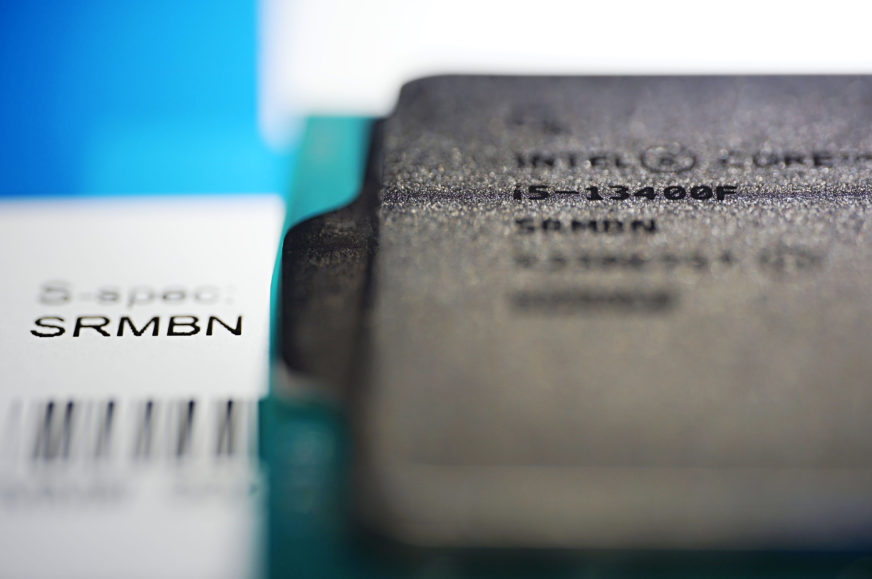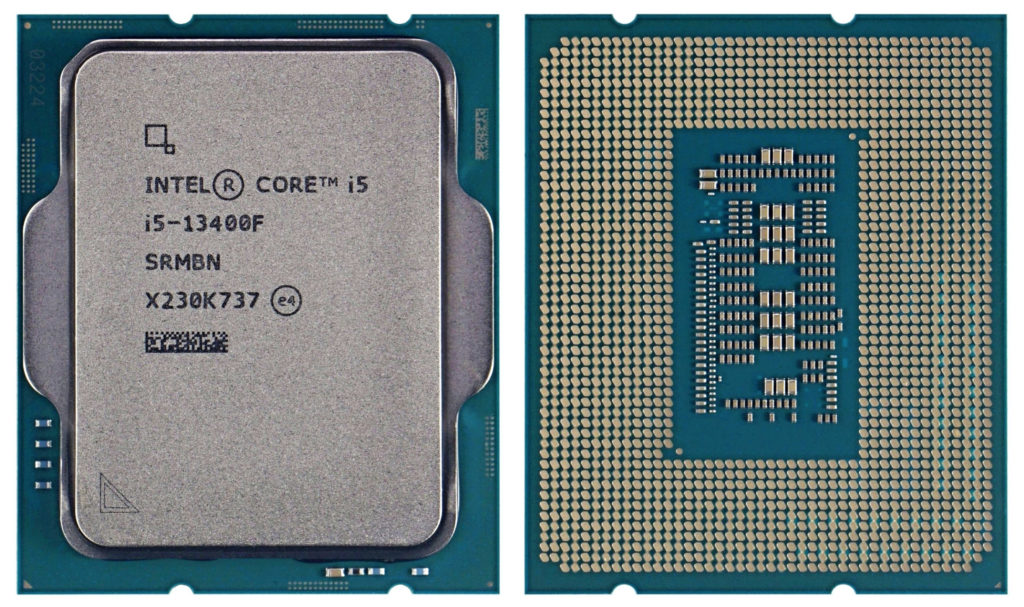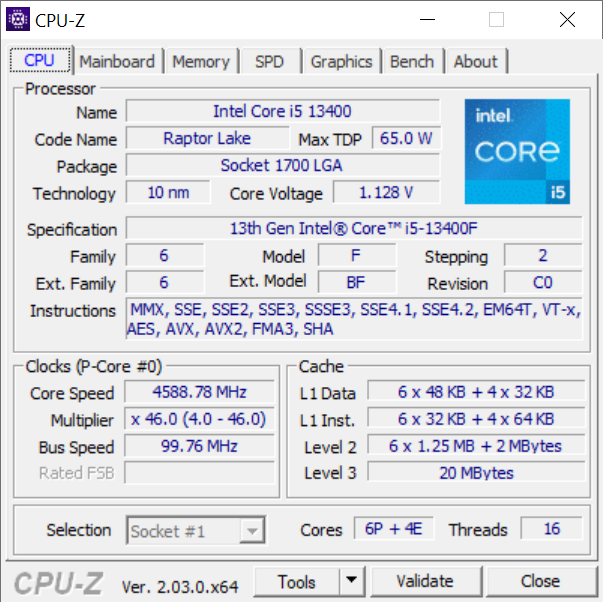Intel Core i5-13400F in detail
Thanks to the addition of E cores even in the lowest Core i5 Raptor Lake models (13400F and 13400), the raw performance between generations has advanced the most in years. However, the improvement may not always happen, the relatively small number of performance ones (P) combined with the lower Turbo Boost 2.0 clock speeds some games don’t like, and when they reach for E cores, the concept of big.LITTLE is at once detrimental.
Intel Core i5-13400F in detail
While previous generations of Core i5-1×400(F), Alder Lake and Comet Lake had physically six cores with Hyper Threading support (i.e. two threads per core), Raptor Lake already has 10 cores. Six large (with HT) and four small (E), with 16 threads total.
Like the Core i5-12400(F), the Core i5-13400(F) comes in two variants, each using a different chip. The processor with the S-Spec code SRMBN (stepping C0) has the smaller one (~209 mm²), of the Alder Lake processors (natively with 8 “P” and 8 “E” cores), the other, with an area of approximately 257 mm (S-Spec code SRMBG, stepping B0) is based on a Raptor Lake chip and is also produced by the newer Intel 7 Ultra manufacturing node. There may thus be some differences in efficiency and cooling across the variants.
There were also differences in operating characteristics across the steppings (C0 and H0) for the Core i5-12400(F). Computing and gaming performance, however, will most likely be the same, as Intel does not differentiate in the clock speed parameters, and for both C0 and B0 stepping, the base all-core boost is 2.5 GHz (for P cores) and 1.8 GHz (for E cores). In practice, without limited power supply (but even with it, according to TDP/65 W), all-core boost clock speeds are significantly higher, compared to the Core i5-12400(F) on P cores by 100 MHz (4100 MHz). The single-core boost by up to 400 MHz (4600 MHz). Despite the fact that this line still only supports TB 2.0, Intel has significantly increased performance for single-threaded applications. This is probably also with a view to not dramatically lag behind the Ryzen 5 7000 processors in this regard, where even the lower model (7600) reaches 5200 MHz, higher (7600X) then up to 5500 MHz. The Core i5-13400(F) is thus “only” 900 MHz slower in single-threaded tasks.
For the tests, we used the variant with stepping C0 out of the two possible ones, which has a unique order number CM8071505093005 (tray)/BX8071513400FSRMBN (box) in addition to a different S-Spec code (SRMBN). This can be a helpful identifier when purchasing a particular variant. The Core i5-13400F with the S-Spec code SRMBG (stepping B0) has the order number CM8071504821107 (tray).
As always, the “F” in the processor’s codename signifies a non-functional or deactivated graphics core, and included is the Intel Laminar RM1 cooler. We discussed the latter in a separate test, where it showed good results (with limited power according to the TDP of 65 W, the operation is also relatively quiet after the PWM curve is adjusted) even for the Ci5-12400 under maximum load, from which the Core i5-13400(F) is not that far. PL2 145 W is vastly exaggerated for these processors, power draw is always significantly lower, under 100 W.
| Manufacturer | Intel | Intel | AMD | |
| Line | Core i5 | Core i5 | Ryzen 5 | |
| SKU | 13400F | 12400 | 7600 | |
| Codename | Raptor Lake | Alder Lake | Raphael | |
| CPU microarchitecture | Golden Cove (P) + Gracemont (E) | Golden Cove (P) | Zen 4 | |
| Manufacturing node | 7 nm | 7 nm | 5 nm + 6 nm | |
| Socket | LGA 1700 | LGA 1700 | AM5 | |
| Launch date | 01/03/2023 | 01/04/2022 | 01/10/2023 | |
| Launch price | 196 USD | 192 USD | 229 USD | |
| Core count | 6+4 | 6 | 6 | |
| Thread count | 16 | 12 | 12 | |
| Base frequency | 2.5 GHz (P)/1.8 GHz (E) | 2.5 GHz (P) | 3.8 GHz | |
| Max. Boost (1 core) | 4.6 GHz (P)/3.3 GHz (E) | 4.4 GHz (P) | 5.1 GHz (unofficially 5,16 GHz) | |
| Max. boost (all-core) | 4.1 GHz | 4.0 GHz (P) | N/A | |
| Typ boostu | TB 2.0 | TB 2.0 | PB 2.0 | |
| L1i cache | 32 kB/core (P)/64 kB core (E) | 32 kB/core (P) | 32 kB/core | |
| L1d cache | 48 kB/core (P)/32 kB/core | 48 kB/core (P) | 32 kB/core | |
| L2 cache | 1,25 MB/jadro (P)/ 2×2 MB/4 cores (E) | 1,25 MB/core (P) | 1 MB/core | |
| L3 cache | 1× 20 MB | 1× 18 MB | 1× 32 MB | |
| TDP | 65 W | 65 W | 65 W | |
| Max. power draw during boost | 148 W (PL2) | 117 W (PL2) | 88 W (PPT) | |
| Overclocking support | No | No | Yes | |
| Memory (RAM) support | DDR5-4800/DDR4-3200 | DDR5-4800/DDR4-3200 | DDR5-5200 | |
| Memory channel count | 2× 64 bit | 2× 64 bit | 2× 64 bit | |
| RAM bandwidth | 76.8 GB/s/51.2 GB/s | 76.8 GB/s or 51.2 GB/s (DDR4) | 83,2 GB/s | |
| ECC RAM support | No | No | Yes (depends on motherboard support) | |
| PCI Express support | 5.0/4.0 | 5.0/4.0 | 5.0 | |
| PCI Express lanes | ×16 (5.0) + ×4 (4.0) | ×16 (5.0) + ×4 (4.0) | ×16 + ×4 + ×4 | |
| Chipset downlink | DMI 4.0 ×8 | DMI 4.0 ×8 | PCIe 4.0 ×4 | |
| Chipset downlink bandwidth | 16.0 GB/s duplex | 16.0 GB/s duplex | 8,0 GB/s duplex | |
| BCLK | 100 MHz | 100 MHz | 100 MHz | |
| Die size | ~209 or ~257 mm² (depending on variant) | ~209 or ~160 mm² (depending on variant) | 66,3 mm² + 118 mm² | |
| Transistor count | ? bn. | ? bn. | 6,57 + 3,37 bn. | |
| TIM used under IHS | Solder | Solder | Solder | |
| Boxed cooler in package | Intel Laminar RM1 | Intel Laminar RM1 | Wraith Stealth | |
| Instruction set extensions | SSE4.2, AVX2, FMA, SHA, VNNI (256-bit), GNA 3.0, VAES (256-bit), vPro | SSE4.2, AVX2, FMA, SHA, VNNI (256-bit), GNA 2.0, VAES (256-bit) | SSE4.2, AVX2, FMA, SHA, VAES (256-bit), AVX-512, VNNI | |
| Virtualization | VT-x, VT-d, EPT | VT-x, VT-d, EPT | AMD-V, IOMMU, NPT | |
| Integrated GPU | N/A | UHD 730 | AMD Radeon | |
| GPU architecture | – | Xe LP (Gen. 12) | RDNA 2 | |
| GPU: shader count | – | 24 | 128 | |
| GPU: TMU count | – | 12 | 8 | |
| GPU: ROP count | – | 8 | 4 | |
| GPU frequency | – | 350–1550 MHz | 400–2200 MHz | |
| Display outputs | – | DP 1.4a, HDMI 2.0b | DP 2.0, HDMI 2.1 | |
| Max. resolution | – | 5120 × 3200 px (60 Hz) | 3840 × 2160 px (60 Hz) | |
| HW video encode | – | HEVC, VP9 | HEVC, VP9 | |
| HW video decode | – | AV1, HEVC, VP9 | AV1, HEVC, VP9 |
- Contents
- Intel Core i5-13400F in detail
- Methodology: performance tests
- Methodology: how we measure power draw
- Methodology: temperature and clock speed tests
- Test setup
- 3DMark
- Assassin’s Creed: Valhalla
- Borderlands 3
- Counter-Strike: GO
- Cyberpunk 2077
- DOOM Eternal
- F1 2020
- Metro Exodus
- Microsoft Flight Simulator
- Shadow of the Tomb Raider
- Total War Saga: Troy
- Overall gaming performance
- Gaming performance per euro
- PCMark and Geekbench
- Web performance
- 3D rendering: Cinebench, Blender, ...
- Video 1/2: Adobe Premiere Pro
- Video 2/2: DaVinci Resolve Studio
- Graphics effects: Adobe After Effects
- Video encoding
- Audio encoding
- Broadcasting (OBS and Xsplit)
- Photos 1/2: Adobe Photoshop and Lightroom
- Photos 2/2: Affinity Photo, Topaz Labs AI Apps, ZPS X, ...
- (De)compression
- (De)encryption
- Numerical computing
- Simulations
- Memory and cache tests
- Processor power draw curve
- Average processor power draw
- Performance per watt
- Achieved CPU clock speed
- CPU temperature
- Conclusion











I wonder how the gaming results, especially power consumption, would look with E-cores turned off. Also, whether the Raptor Lake stepping has any performance advantage over Alder Lake one.
We will do ASAP.
After all, it seems that it might not be so easy to get Ci5-13400F in stepping B0. Big domestic shops (on the Czech-Slovak market) have only stepping C0 available, but we believe that sooner or later at least one piece will appear for testing. The availability of the variant based on Raptor Cove will probably be very low.
When we were looking for Ci5-12400 stepping H0 last year, they were also in the minority, but there were still some, about in 40/60 ratio (H0/C0). It’s worse over here, and Intel is obviously trying to use as many B0 “silicon” as possible for more powerful processors.